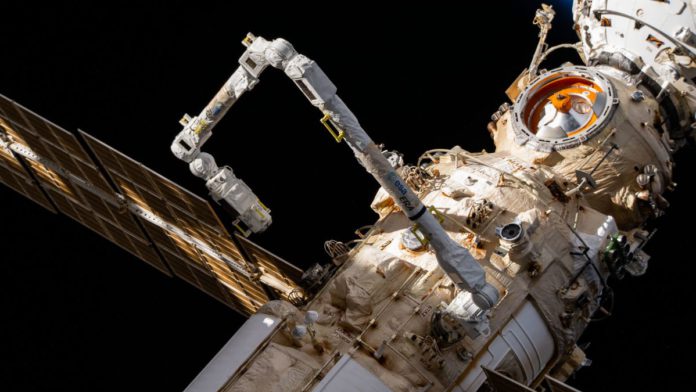On Friday, Roscosmos’s Expedition 67 Commander Oleg Artemyev and Flight Engineer Denis Matveev completed their spacewalk at 5:12 p.m. EDT. They succeeded in accomplishing their primary goals, which included relocating the European robotic arm’s exterior control panel from one operating area to another and testing a rigidizing mechanism that would be utilized to make it easier to grab payloads. By opening the hatch of the Poisk docking compartment airlock, the duo had to outfit the European robotic arm on the Nauka laboratory of the International Space Station (ISS). Furthermore, the team moved a Strela telescoping boom from the Zarya module to the Poisk module.
The European robotic arm (ERA) for European Space Agency (ESA) was created by a European team under the direction of Airbus Defense and Space in the Netherlands. Launched into orbit in July 2021, the robotic arm is designed to function like a human arm but can lift up to 17,600 pounds (8 tonnes) when operating outside the orbiting space station. The robot arm, which is the first to be capable of anchoring itself to the ISS, has two hands and can move back and forth by crossing one hand over the other like an inchworm. By transferring payloads as they arrive at the space station without the need for spacewalking humans, the arm lessens the workload on the ISS astronauts. It can also help transport astronauts when they are performing spacewalks. Apart from this arm, ISS already has the Canadian-built Canadarm2 robotic arm, and the Japanese arm currently assisting station maintenance, operations, and research.
Read More: NASA leverages AI-based CFD to Develop Hypersonic Missiles
According to information released by ESA, the European robotic arm successfully carried out its maiden transfer outside of the International Space Station on August 24. The arm maneuvered in accordance with instructions from Russian cosmonauts (astronauts) on board to release a tiny payload from a single pin latch on the Nauka science module. The payload was then put back in its original position after being transferred to the other side by the robot. The process took around six hours, and then the robot resumed its hibernation.
The main reason behind the latest spacewalk was to complete unfinished tasks from the August 17 EVA (extravehicular activity, or spacewalk), i.e., VKD-54. If two or more Russian spacewalks are carried out by the same crew, a suffix (“a,” “b,” etc.) is added to any prior unplanned or emergency spacewalks. So, the EVA on Friday was given the name VKD-54a. Officially, VKD-54a was the eighth spacewalk in 2022 and the 253rd overall to assist the International Space Station. It was also Matveev’s fourth spacewalk and Artemyev’s eighth spacewalk overall in his career as an astronaut.
For their journey outside the Station, both men donned Russian Orlan-MKS spacesuits, with Artemyev’s having red stripes and Matveev’s having blue stripes.
On Friday, September 2, at 13:25 UTC, the hatch on the Poisk module was opened, signaling the formal commencement of the EVA. A little while later, Artemyev and Matveev exited the airlock.
The two cosmonauts moved to the Nauka module once they were outside and set up a payload adapter platform there. They then began moving the External Man Machine Interface (EMMI) control panel, which enables spacewalkers to operate the European Robotic Arm during EVAs manually. Artemyev and Matveev used the EMMI to translate from the side to the front of Nauka, then put the control panel on a handrail and hooked it to the BLT3 base point via a cable.
The EMMI was then turned on, and Artemyev was instructed to test the controls, which worked according to plan. Next, the team verified and configured several settings on each of the European Robotic Arm’s end effectors using a rotating torquing tool, confirming with ground control in Moscow intermittently to ensure each setting was accurate.
To reposition the European Robotic Arm, Artemyev and Matveev then unhooked End Effector 1’s launch restraint ring. The robotic arm’s testing went off without a hitch, with orders to slowly approach and eventually grip the BTL2 base point on Nauka.
After the European Robotic Arm’s movement testing was over, Artemyev was advised to return to the EMMI for more inspections, which were successfully carried out. The EMMI was then put into storage mode, and Artemyev moved to complete mounting a set of soft handrails to the side of the Nauka module. Since the two cosmonauts were working significantly ahead of schedule, mission control decided to proceed with completing get-ahead tasks before the next EVA. One of these was creating a translation route by extending the Strela boom from its base on the forward end of the Zarya module to the Poisk airlock module.
Although it was postponed from a previous spacewalk, this mission was nevertheless crucial since subsequent EVAs will use it to relocate Nauka’s airlock and radiator.


